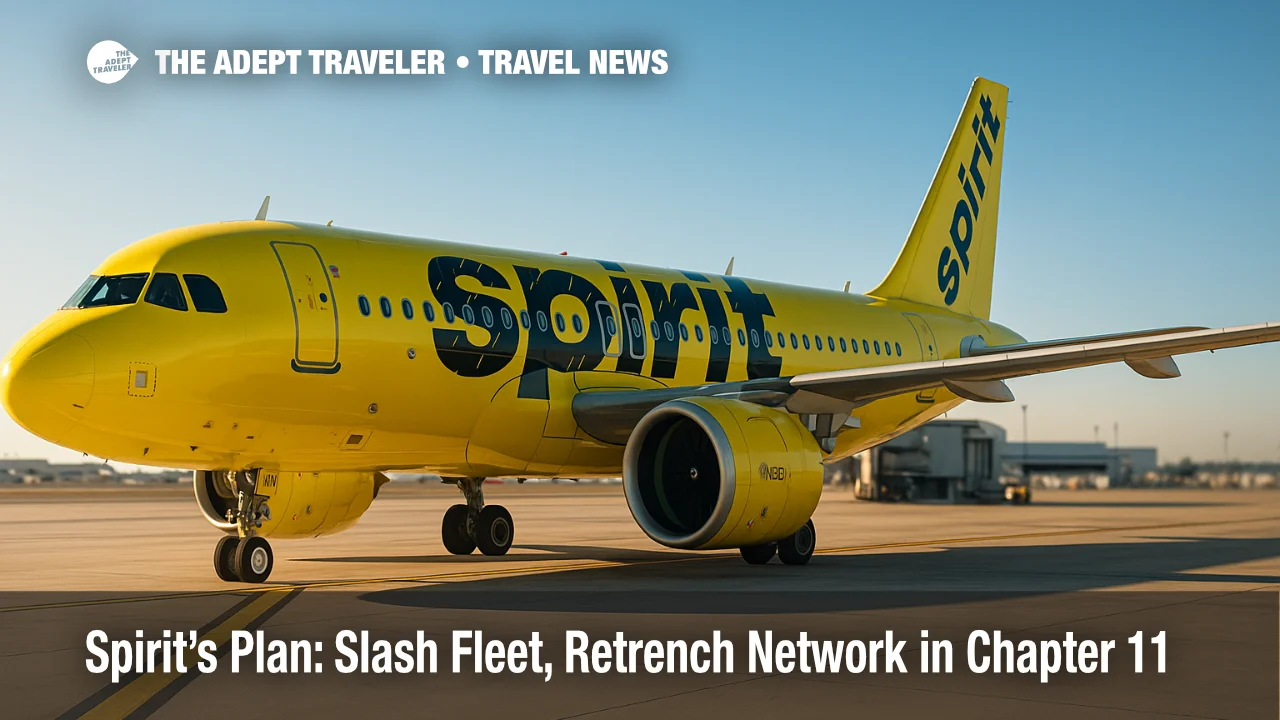Spirit's plan: slash fleet, retrench network in Chapter 11

Spirit Airlines outlined a sweeping fleet reduction as part of its Chapter 11 restructuring, moving to reject 87 aircraft leases and preparing to exit more than a dozen U.S. airports. Executives told creditors the carrier, which has 214 aircraft, aims to save "hundreds of millions of dollars" by supporting a much smaller operation while it negotiates with lessors through October 27. The plan follows a separate settlement that terminates leases on 27 AerCap aircraft and provides a $150 million payment to Spirit.
Key points
- Why it matters: Spirit Airlines fleet reduction reshapes U.S. low-cost competition and capacity.
- Travel impact: Exits include Bradley International (BDL) and Minneapolis-Saint Paul (MSP).
- What's next: Court will consider Spirit's motion to reject 87 aircraft leases.
- Spirit targets "hundreds of millions" in savings via a smaller, stronger network.
- AerCap settlement ends leases on 27 planes and delivers $150 million to Spirit.
Snapshot
Spirit's latest court motion seeks authority to reject 87 aircraft leases, a cut approaching 40 percent of its 214-jet fleet. The airline said the motion remains subject to court approval and ongoing talks with lessors. CFO Fred Cromer told creditors this week that expected market improvements in 2025 did not materialize, citing overcapacity and weaker yields. Separately, Spirit has already secured a settlement with AerCap that terminates leases for 27 aircraft and provides $150 million in cash, helping fund near-term restructuring steps. Network retrenchment is underway, with plans to leave more than a dozen U.S. airports, including Bradley International Airport (BDL) and Minneapolis-Saint Paul International Airport (MSP).
Background
Spirit entered Chapter 11 again in late summer 2025 amid persistent losses and cash pressure. In recent days, the company also lined up up to $475 million in debtor-in-possession financing from bondholders to maintain operations while it restructures. The fleet plan consolidates earlier actions, including the AerCap agreement covering 27 aircraft and targeted route suspensions. Management argues that pulling down capacity, rejecting uneconomic leases, and concentrating flying in core stations is essential to restore profitability. The court has also approved portions of non-aircraft restructuring, such as select airport and ground-handling contract rejections, as Spirit pivots toward a smaller footprint with fewer bases and tighter scheduling.
Latest developments
Spirit Airlines fleet reduction accelerates under Chapter 11
In a new filing, Spirit asked the court to reject 87 aircraft leases spanning A320ceo and A320neo family jets, with decisions on precise fleet needs due by October 27. Cromer told creditors the strategy would produce "hundreds of millions of dollars" in cost savings and allow Spirit to drop underperforming routes and stations. The carrier also confirmed plans to leave more than a dozen airports, with local notices identifying Hartford-area Bradley International (BDL) service ending October 31 and Minneapolis-Saint Paul (MSP) departures ending December 1. Concurrently, the AerCap settlement removes 27 aircraft from future obligations and delivers $150 million to Spirit, resolving disputes tied to forthcoming Airbus deliveries. Spirit reiterated that its latest lease-rejection motion is subject to court approval, and that lessor negotiations continue.
Analysis
For travelers, Spirit's fleet and network reset means fewer ultra-low fares in some secondary and mid-size markets where the airline was a price leader. Exits at Bradley International and Minneapolis-Saint Paul illustrate a broader pattern: pull down where unit revenues lag and concentrate in stations with stronger demand, connectivity, and operational performance. The combination of 87 prospective lease rejections plus the AerCap deal on 27 aircraft points to a materially smaller airline, potentially near or just above 100 active frames depending on final negotiations and returns. That scale could simplify maintenance, staffing, and scheduling, improving completion rates and on-time metrics. The trade-off is reduced schedule breadth and fewer impulse-priced options on peak days, which may nudge fares higher where legacy carriers and larger ULCCs face less head-to-head pressure. Spirit's DIP financing and staged lease exits buy time, but the court's rulings and lessor agreements over the next three weeks will determine just how deep the fleet reduction goes, and how quickly the trimmed network can stabilize cash flow.
Final thoughts
If approved as filed, Spirit's plan would mark one of the sharpest pullbacks by a U.S. carrier in recent memory. Watch for rolling schedule changes, airport exits, and aircraft redeliveries as the October 27 milestone approaches, along with updates on financing access and any additional contract rejections. Travelers should verify itineraries well ahead of departures at airports flagged for exit and consider alternates where capacity tightens. The outcome will define whether a leaner operation can deliver the "smaller and stronger" promise at the heart of Spirit Airlines fleet reduction.
Sources
- Spirit Airlines announces significant progress toward a successful restructuring, Spirit IR
- Spirit Airlines to cut fleet by almost 100 planes amid bankruptcy restructuring, Reuters
- Spirit Airlines gets up to $475 million financing amid bankruptcy process, Reuters
- Spirit Airlines to end Bradley International service in October, CT Insider
